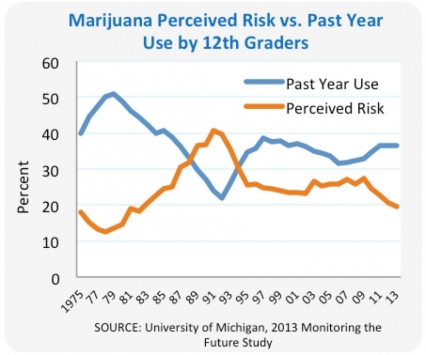
Every year, the Monitoring the Future (MTF) survey measures drug, alcohol, and tobacco use and related attitudes among 8th, 10th, and 12th graders. Following are facts and statistics about youth substance use from the 2013 MTF report
Illicit drug use among teenagers remains high, largely due to increasing popularity of marijuana. Marijuana use by adolescents declined from the late 1990s until the mid-to-late 2000s, but has been on the increase since then. In 2013, 7.0 percent of 8th graders, 18.0 percent of 10th graders, and 22.7 percent of 12th graders used marijuana in the past month, up from 5.8 percent, 13.8 percent, and 19.4 percent in 2008. Daily use has also increased; 6.5 percent of 12th graders now use marijuana every day, compared to 5 percent in the mid-2000s.
Rising marijuana use reflects changing perceptions and attitudes. Historically, as perception of risks goes down, use goes up (and vice versa). Young people are showing less disapproval of marijuana use and decreased perception that marijuana is dangerous. The growing perception of marijuana as a safe drug may reflect recent public discussions over “medical marijuana” and movements to legalize the drug for adult recreational use in some states.
Courtesy National Institute on Drug Abuse, National Institute of Health
Other Related Articles
- How Does Addiction Take Hold in the Brain?
- Drugs Of Abuse Target The Brain’s Pleasure Center
- Brain and Heart Metabolism
- The Neurobiology of Drug Addiction
- Addiction is similar to other chronic diseases. Like heart disease, drug addiction can be prevented and treated successfully. If left untreated, however, its effects can last a lifetime.
- New synthetic drugs are a cause for concern, but their use is not increasing
- Positive trends in the past several years include reduced use of inhalants and less use of cocaine, especially crack cocaine.
- Fewer teens smoke cigarettes than smoke marijuana.
- Other forms of smoked tobacco are becoming popular, however



